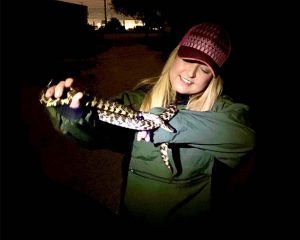DAVIE, FL. – In Florida, native snakes play an important role in the environment that we live and enjoy. Now that role is being threatened by invasive Burmese pythons introducing a non-native lung parasite to nearly half of the sunshine state’s counties in southern Florida and possibly more.
To make matters worse, native snakes are so susceptible to infection that the parasite has spread northward beyond the range of pythons. “We could have ecosystem wide impacts from this parasite as it is already spreading up the state, and if it continues to spread across North America, we could see even larger impacts,” said Melissa Miller, who joined UF/IFAS Fort Lauderdale Research and Education Center as coordinator of invasive species research for the Croc Docs Laboratory last November. “These parasites present a risk to native snake populations as our native snakes serve as an ideal host allowing the parasites to thrive and reproduce.”

Miller is the lead author of Highly competent native snake hosts extend the range of an introduced parasite beyond its invasive Burmese python host, a study published in the latest edition of Ecosphere, a journal of the Ecological Society of America, this month. The study sheds light on the parasite’s current impacts on Florida’s native snakes and documents its spread to native snakes outside of the python’s range.
The study demonstrates a case where invasive species can exert impacts well beyond their distribution. Miller made the initial discovery that the parasite was introduced by Burmese pythons and conducted the research while attending Auburn University as a doctoral candidate co-advised by Christina Romagosa, research associate professor at UF/IFAS Wildlife Ecology and Conservation, and Craig Guyer, emeritus professor in Biological Sciences at Auburn University. Miller plans to continue her research as part of her role at the UF/IFAS Fort Lauderdale Research and Education Center.
Florida is home to 46 species of native snakes, only six of which are venomous. They are essential to the sunshine state’s environment because they maintain ecosystem balance, regulate prey populations, and reduce pest species such as rodents.
Florida’s populations of reptiles and amphibians are strikingly out of balance as a result of nonnative species invasions. Burmese pythons (Python bivittatus) are native to Southeast Asia. Researchers believe its introduction to southern Florida emerged through the pet trade industry and, due to accidental and intentional releases, has led to it successfully establishing as an invasive species for more than two decades. This large, constrictor predator may grow upward of 20 ft in length. In Florida, Burmese pythons are known to prey on more than 60 species of native mammals, birds, and reptiles, including some of the state’s at-risk species.
“Co-introduced pathogens and parasites, such as these lung parasites, are not often considered in the research and management of biological invasions. This study adds to the growing knowledge of disease impacts associated with the global movement of animals,” added Romagosa.
For the study, Miller examined 523 deceased snakes, salvaged dead on roads, and recorded 13 species native to Florida that the parasite has infected. This number represents 48 percent of the snake species in extreme southern Florida (Monroe and Miami-Dade counties) which indicates a significant potential for ecosystem level impacts, she said.
The study focused within geographic boundaries including the core of the Burmese python population, the python invasion front, and regions where pythons are not present. The boundaries examined for the python invasion front and core of the python population stretched across the state from the Gulf of Mexico to the Atlantic Ocean starting from the northern county lines of Manatee, Hardee, Highlands, Okeechobee, and Saint Lucie to the southernmost tips of Miami-Dade and Monroe counties. Miller’s research also recorded a northward trend into Florida’s mid and northern counties where she found infected native snakes in Polk and Lake counties. No infected snakes were found north of Alachua county, but Miller suspects at the rate the parasite is spreading they will be soon.
While it is not clear if the snakes die from the parasite, how the snakes become infected is being revealed. As female parasites release eggs in the python, the eggs are expelled through defecation into the wild. These eggs are consumed by an intermediate host that serves as prey for the snake. Miller’s research has found mammals and lizards can serve as intermediate hosts; her current findings suggest frogs likely serve as additional key intermediate hosts as well.
“Our study provides evidence that the parasite thrives in native snakes. In some cases, a single host contained up to 77 parasites in its lung, which can reduce pulmonary function and affect a host’s ability to successfully compete with other species and avoid predation; this may ultimately lead to declines in native host populations” said Miller. In addition to native species, Miller has found the parasite infects non-native lizards in Florida, such as geckos and tegus, and she is currently examining the implications of infection in these non-native hosts.
Additional research is needed to determine the magnitude of adverse effects on native snakes and intermediate hosts as well as the extent to which this parasite may continue to spread outside of the range of pythons.
Funding for this research was possible through the Auburn University’s Center for Environmental Studies at the Urban-Rural Interface in the School of Forestry and Wildlife Sciences and the Department of Biological Sciences.
Photo credit: Kodiak C. Hengstebeck
By: Lourdes Rodriguez, 954-577-6363 office, 954-242-8439 mobile, rodriguezl@ufl.edu
-30-
The mission of the University of Florida Institute of Food and Agricultural Sciences (UF/IFAS) is to develop knowledge relevant to agricultural, human and natural resources and to make that knowledge available to sustain and enhance the quality of human life. With more than a dozen research facilities, 67 county Extension offices, and award-winning students and faculty in the UF College of Agricultural and Life Sciences, UF/IFAS brings science-based solutions to the state’s agricultural and natural resources industries and all Florida residents.
 0
0
